A sanctuary of serenity and spiritual harmony, set against the majestic backdrop of Mount Agung, embodying centuries of Balinese faith and tradition.
Embark on a spiritual journey to Besakih Temple, the most sacred and largest of Bali’s temples.
Nestled on the slopes of Mount Agung, this sprawling complex is not just an architectural marvel; it’s a pillar of Balinese Hindu tradition, offering breathtaking views and a profound sense of peace.
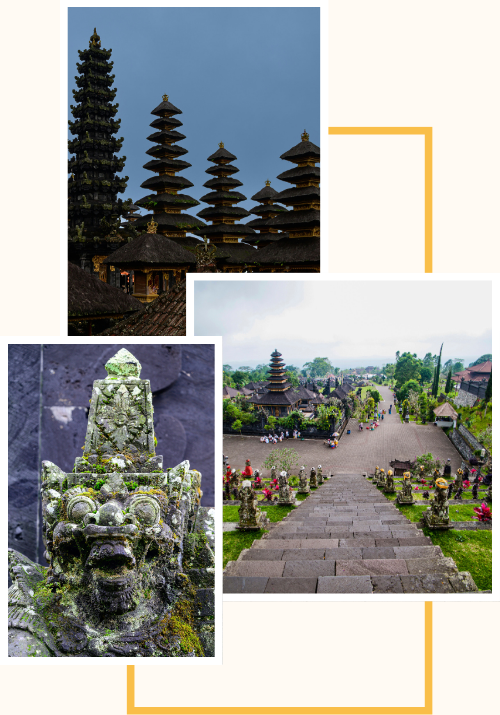

The temple is open 24 hours for paid tickets, tickets for tourists open from 7am-6pm..
Dress Code:
Sarongs and sashes are required for both men and women. These can be rented at the entrance.
Early morning or late afternoon for fewer crowds and cooler temperatures. The temple is especially vibrant during Hindu festivals like Galungan, Kuningan, and the temple’s annual anniversary, Piodalan, which is celebrated according to the Balinese calendar, every 210 days.

Bali’s spiritual summit, offering treks through mystical landscapes to panoramic vistas that touch the sky, embodying the island’s essence.
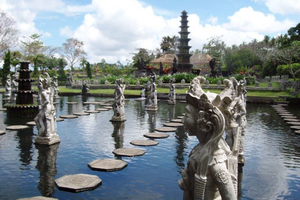
Step into a royal garden filled with crystal-clear pools, ornate sculptures, and lush foliage, a testament to Bali’s water worship and artistic heritage.
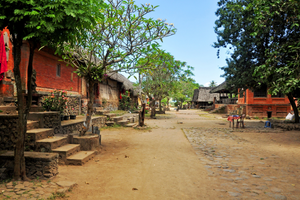
Step back in time in this secluded Bali Aga village, known for its preserved customs, unique rituals, and the rare double ikat weaving.
Known as the "Mother Temple,"
Besakih is over 1,000 years old.
Originally made up of over 80 temples, today the complex comprises 23 separate but related temples.

The largest and most important building is the Pura Penataran Agung.
Besakih survived the devastating volcanic eruptions of Mount Agung in 1963.
Believed by locals to be a miraculous sign of divine intervention.





In 1963, Mount Agung, the highest mountain in Bali, erupted with such ferocity that it devastated surrounding villages and claimed numerous lives.
Remarkably, the Besakih Temple, perched on the mountain's slopes, remained unscathed.
This event reinforced the Balinese people's belief in the temple's divine protection.
It was seen as a miraculous survival, symbolizing the enduring spiritual guardianship of the island and its inhabitants.
The lava flows halted mere meters from the temple's outermost courtyard, a testament to its revered standing and the protective powers attributed to it.
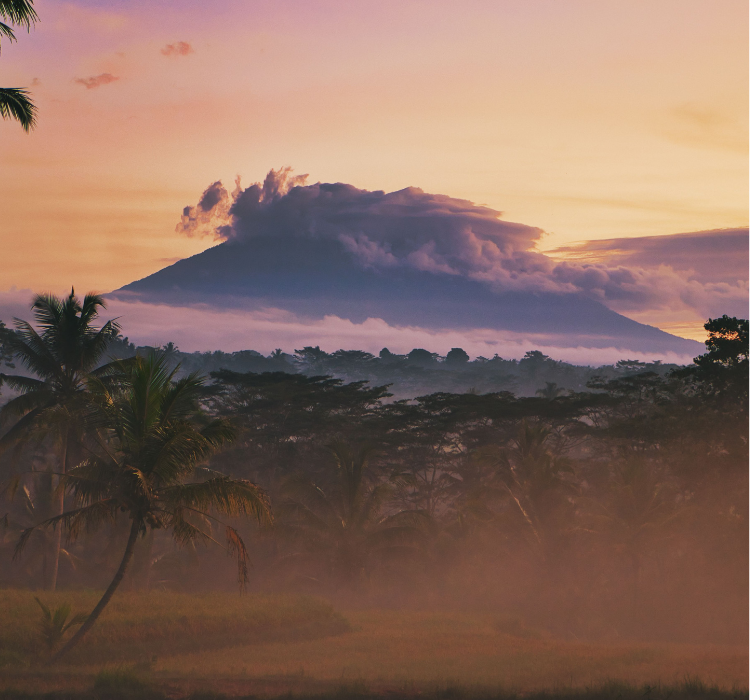
Besakih Temple, known as Bali’s Mother Temple, holds a mystique as ancient as the island itself.
While the exact origins remain shrouded in mystery, it's clear that Besakih has been revered as a sacred site since prehistoric times.
The first historical mention of the temple dates back to an inscription from 1007 AD, confirming its existence and significance. By the 13th century, it was undoubtedly a Hindu temple, a spiritual anchor for the community.
Despite conflicting reports about its establishment in the 8th or 9th centuries, what remains certain is Besakih’s enduring role as a beacon of faith, a testament to Bali’s deep spiritual roots, and a place where the divine and mortal realms converge.
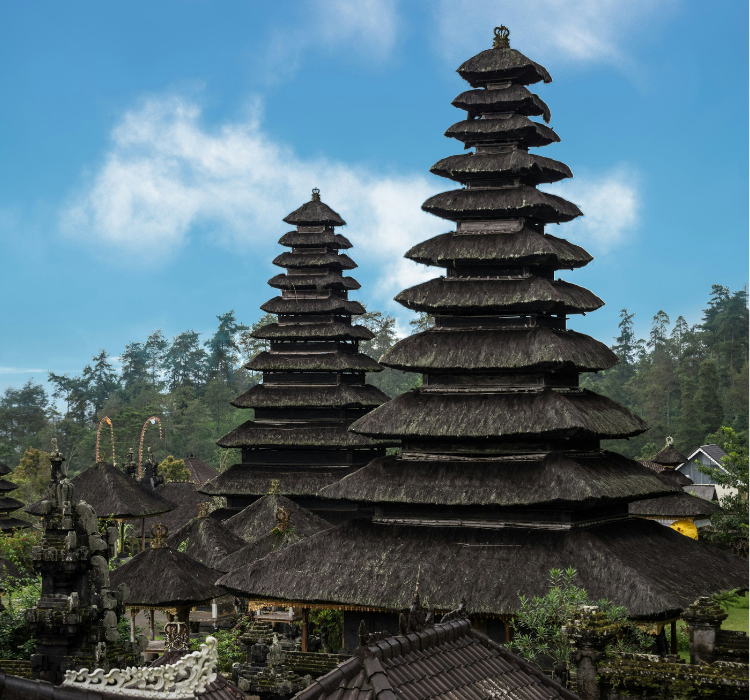
Besakih's odalan (temple anniversary) occurs every 210 days, and sees thousands of devotees participating in elaborate ceremonies, signifying the temple's role as a focal point for Balinese Hindu worship.
This period of festivity and prayer emphasizes purification, spiritual renewal, and devotion, reflecting the temple's essence as a beacon of sacred values and communal harmony.

The temple's layout follows the traditional Balinese concept of tri mandala, representing the three cosmic realms.
Its construction on the mountain slopes symbolizes the Hindu belief in the universe's hierarchical nature, from the profane to the sacred.
The ascending series of courtyards and brick gateways guide pilgrims towards the upper sanctum, illustrating the spiritual journey towards enlightenment.

Besakih Temple stands as a testament to Bali's enduring cultural heritage, blending Hindu-Javanese architecture with indigenous Balinese elements.
It serves not only as a place of worship but also as a cultural repository, preserving ancient rituals, dance, and art forms.
The temple's resilience and the devotion it inspires underscore its role in fostering a sense of identity and continuity among the Balinese people.
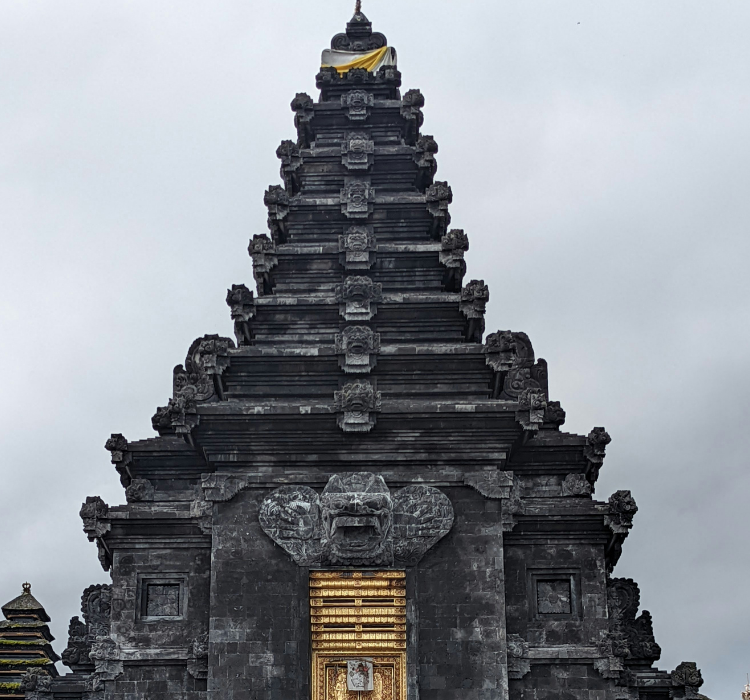
Besakih Temple, known as the "Mother Temple of Bali," hosts over seventy festivals yearly, aligning with the Balinese Pawukon calendar.
These celebrations are a vibrant testament to the island's rich cultural tapestry and spiritual depth.
One of the most significant, the Eka Dasa Rudra, is celebrated once every hundred years, inviting participants to cleanse the world through elaborate rituals and offerings.
These festivals showcase a unique blend of devotion, community spirit, and connection to the natural world, embodying the Balinese people's dedication to maintaining harmony with the divine, the environment, and each other.
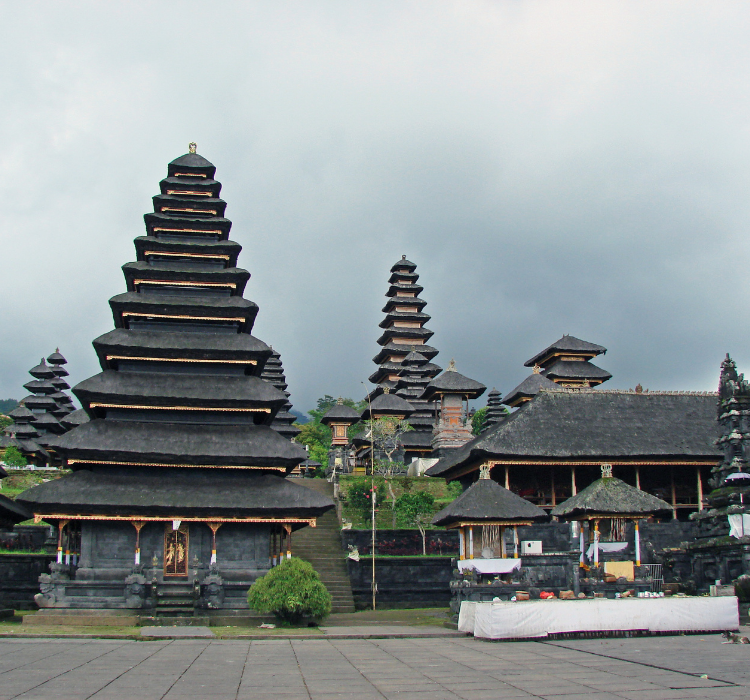
The Besakih Temple complex, sprawling across six levels terraced up Mount Agung's slopes, represents a spiritual journey from the earthly to the divine.
With over 80 temples comprising 23 separate but related compounds, the layout mirrors the cosmic mountain concept central to Balinese Hinduism.
This architectural marvel is designed to facilitate a pilgrim's ascent, both physically and spiritually, towards the sacred peak where the gods reside.
The intricate carvings and gateways at each level symbolize thresholds between the material world and the spiritual realm, offering insights into the Balinese concept of the universe.
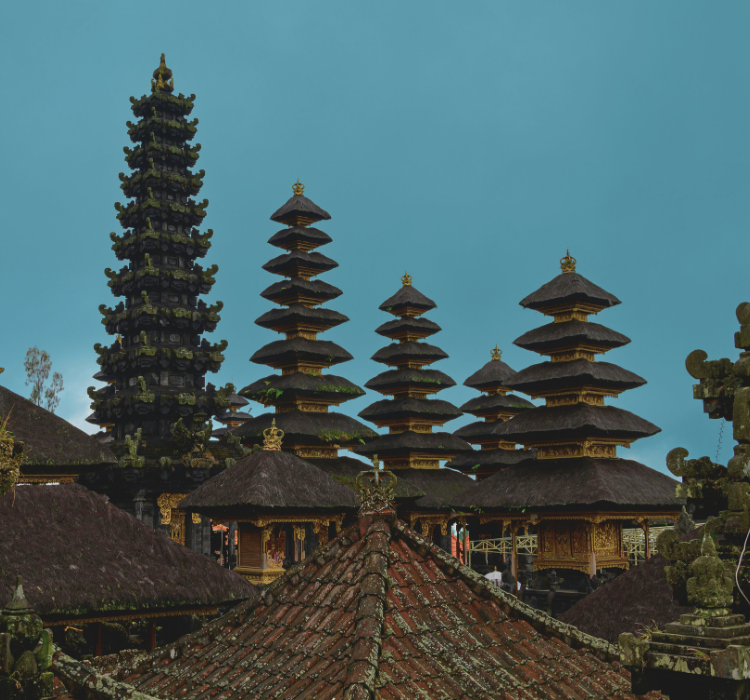
Besakih's history stretches back over a thousand years, making it one of the oldest and most significant spiritual centers in Bali.
Its resilience through natural disasters, including volcanic eruptions and earthquakes, and human challenges, such as the threat of demolition during religious conflicts, marks it as a beacon of endurance.
The temple's ability to withstand the test of time is revered as a symbol of the Balinese people's unyielding faith and their ancestors' wisdom in choosing a location that, despite its apparent vulnerability, has proven to be a sanctuary of lasting spiritual significance.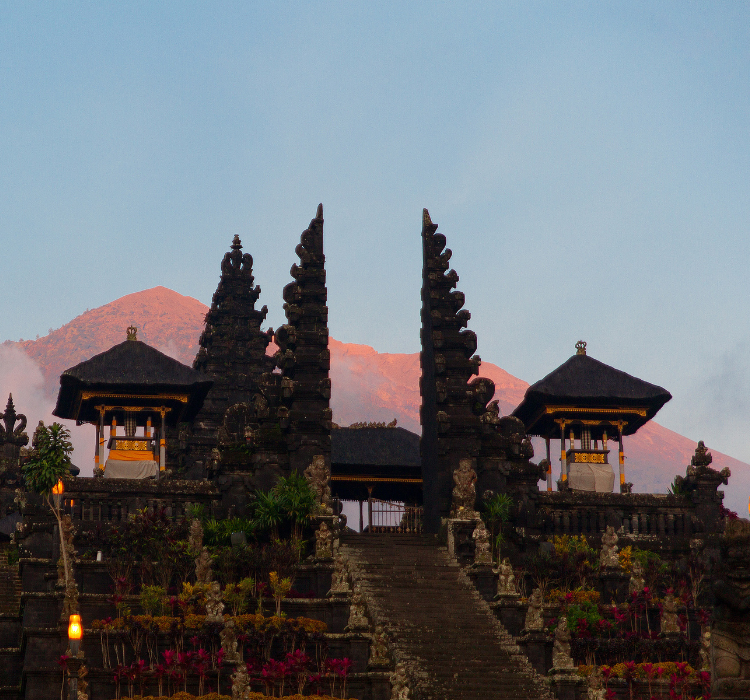
The temple's design reflects a profound respect for and alignment with the natural environment.
Its courtyards merge seamlessly with the mountain's contours, embodying the Balinese philosophy of Tri Hita Karana, which emphasizes the balance and harmony between humans, nature, and the divine.
This principle is evident in the temple's layout, which encourages a symbiotic relationship with the surrounding landscape, fostering a sense of unity and coexistence with the natural world.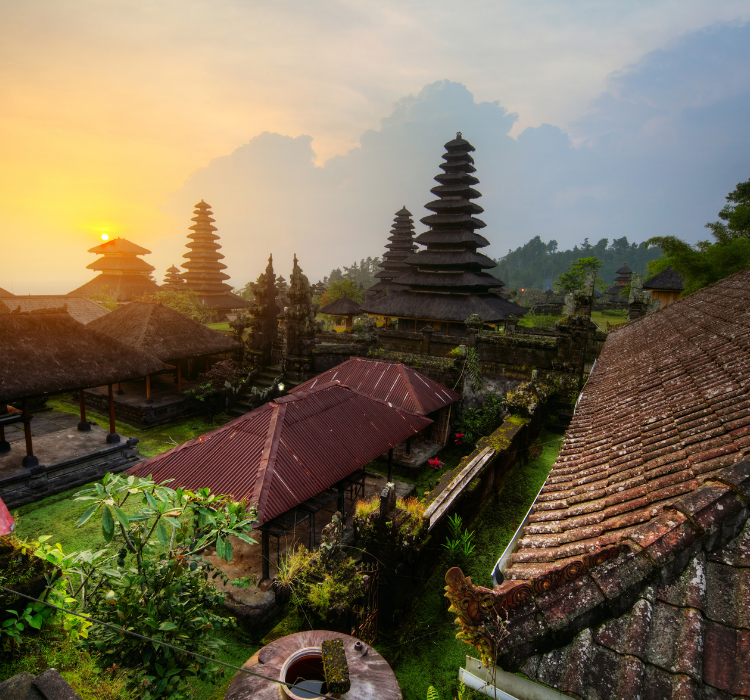
Besakih Temple serves as a living museum, housing artifacts and inscriptions that offer glimpses into Bali's ancient past.
Stone tablets and relics within its compounds tell tales of the island's early dynasties, trade relations, and cultural exchanges with distant lands.
These historical treasures, coupled with the temple's architectural grandeur, provide invaluable insights into the evolution of Balinese civilization, religion, and artistry over centuries.

In the tradition of preserving history for future generations, Besakih Temple contains several inscriptions and ceremonial stones that record the temple's renovations and significant events.
These markers serve as a testament to the community's ongoing commitment to maintaining and honoring their sacred space, ensuring that the temple remains a vibrant center of spiritual and cultural life for centuries to come.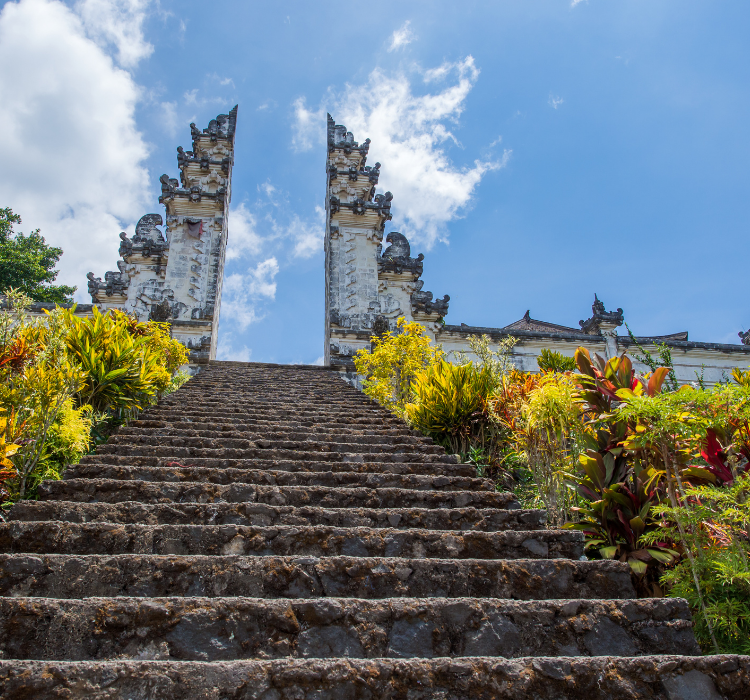
Spiritual leaders establish the foundational site of the Besakih Temple on the slopes of Mount Agung, marking the beginning of its sacred history as the central temple complex of Balinese Hinduism.

The Javanese conquer Bali, leading to a significant infusion of Majapahit culture, architecture, and Hinduism, further enriching Besakih’s spiritual and architectural heritage.

The Javanese conquer Bali, leading to a significant infusion of Majapahit culture, architecture, and Hinduism, further enriching Besakih’s spiritual and architectural heritage.

Besakih Temple emerges as a pivotal sanctuary for Balinese Hinduism, with the expansion of its complex to include multiple temples and shrines, solidifying its status as the “Mother Temple” of Bali.

Mount Agung erupts catastrophically, causing widespread destruction. Miraculously, Besakih Temple remains virtually untouched by the lava flows, an event that is interpreted by many as a divine sign of the temple’s sacred protection.
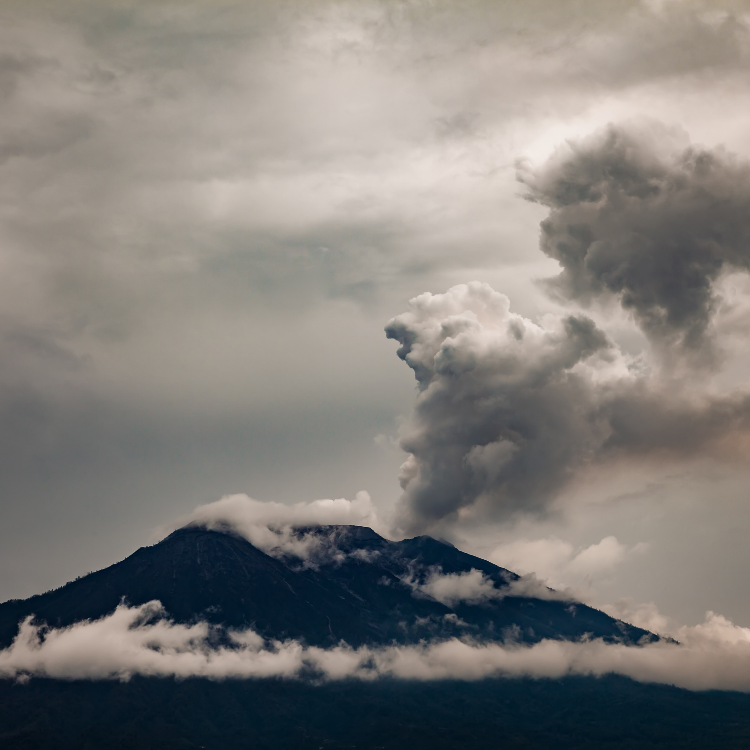
Mount Agung erupts catastrophically, causing widespread destruction. Miraculously, Besakih Temple remains virtually untouched by the lava flows, an event that is interpreted by many as a divine sign of the temple’s sacred protection.

The Indonesian government and international organizations initiate efforts to preserve and restore the temple complex, recognizing its cultural and historical importance.
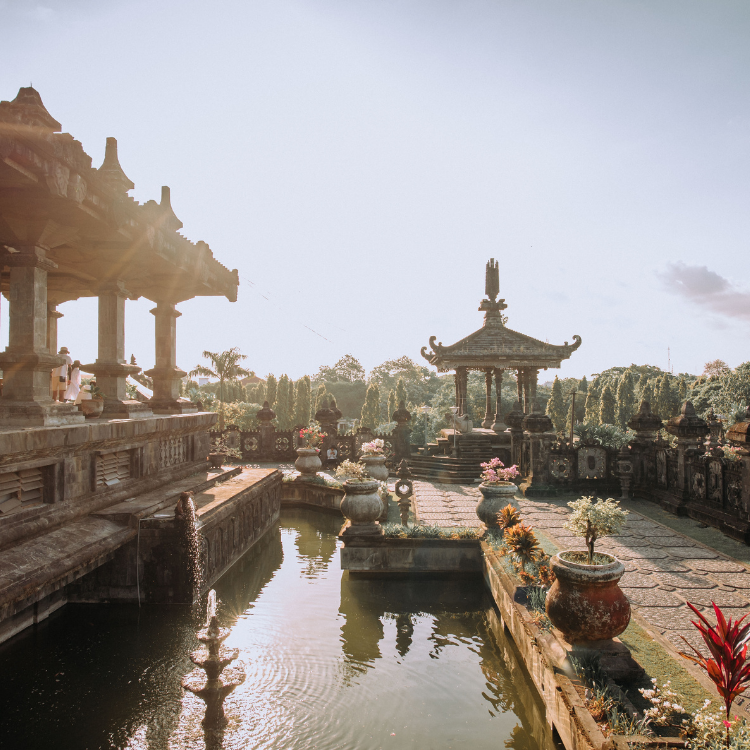
Besakih Temple becomes a UNESCO World Heritage Site nominee, highlighting its architectural and spiritual significance on a global scale.

Besakih Temple becomes a UNESCO World Heritage Site nominee, highlighting its architectural and spiritual significance on a global scale.

After years of protests over economic concern, President Suharto resigned, ushering in a new era of political reform in Indonesia and Bali.
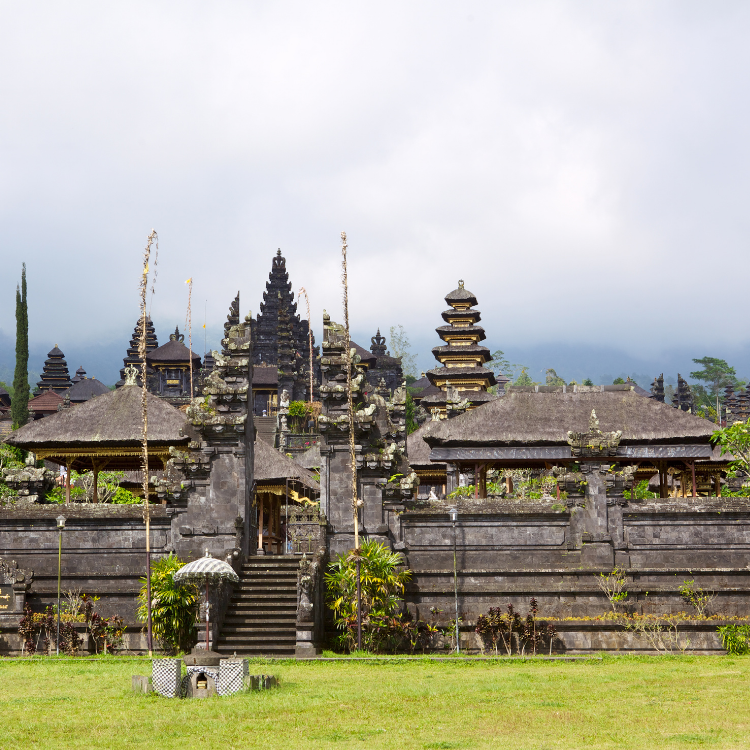
Conservation efforts intensify to maintain the temple’s ancient structures and surrounding environment, ensuring the preservation of its cultural heritage for future generations.

Conservation efforts intensify to maintain the temple’s ancient structures and surrounding environment, ensuring the preservation of its cultural heritage for future generations.

The Besakih Temple hosts a major ceremony commemorating the 1000-year anniversary of its founding, attracting pilgrims and visitors from around the world to celebrate its enduring legacy.
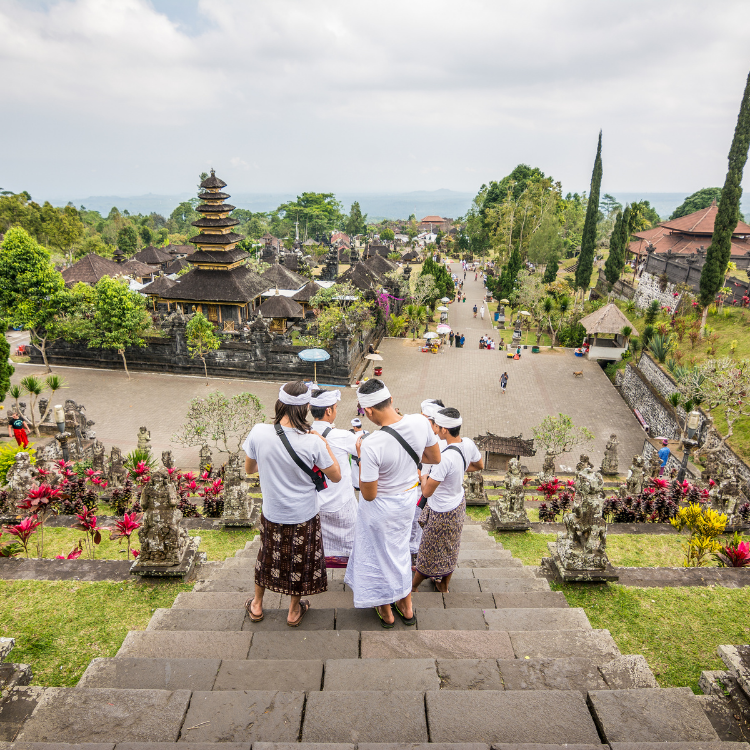
Mount Agung shows signs of volcanic activity, prompting evacuations and concerns for the safety of the temple. The temple remains unharmed, reinforcing its reputation as a protected and sacred place.

Mount Agung shows signs of volcanic activity, prompting evacuations and concerns for the safety of the temple. The temple remains unharmed, reinforcing its reputation as a protected and sacred place.

Besakih Temple continues to be a vibrant center of religious activity, cultural heritage, and pilgrimage, with ongoing efforts to preserve its structures and spiritual legacy against the challenges of modernity and environmental threats.

The temple complex remains a testament to the resilience, faith, and cultural richness of the Balinese people, attracting millions of visitors each year who seek to experience its spiritual ambiance and historical depth.
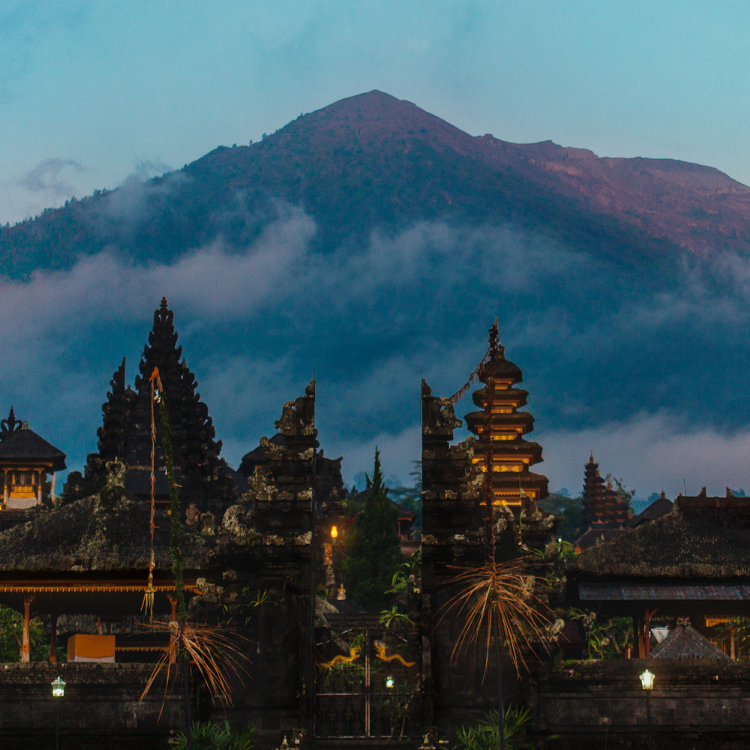
The temple complex remains a testament to the resilience, faith, and cultural richness of the Balinese people, attracting millions of visitors each year who seek to experience its spiritual ambiance and historical depth.

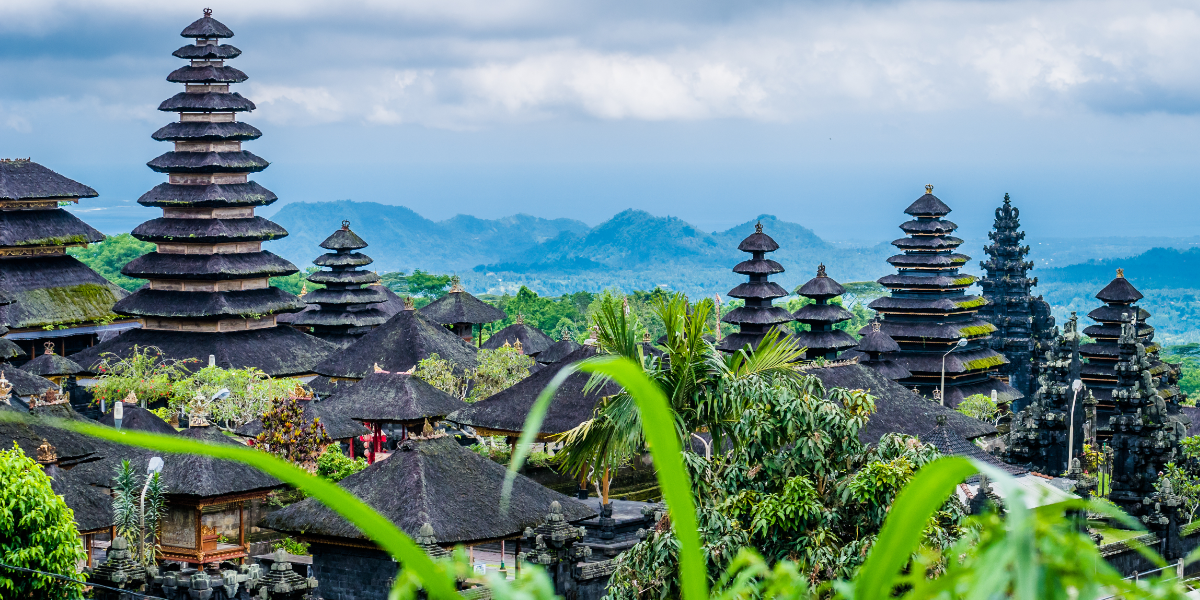
The roots of Besakih Temple are steeped in the mists of Bali’s sacred Mount Agung, which has been considered a sacred site since prehistoric times. While the date of Besakih’s inception is unknown, it is certain that a sense of divine purpose led to the consecration of this spiritual haven.
It’s not known for sure whether or not the temple was established in the 8th century; the temple doesn’t enter the history record until the 11th century, though it almost certainly existed before then.
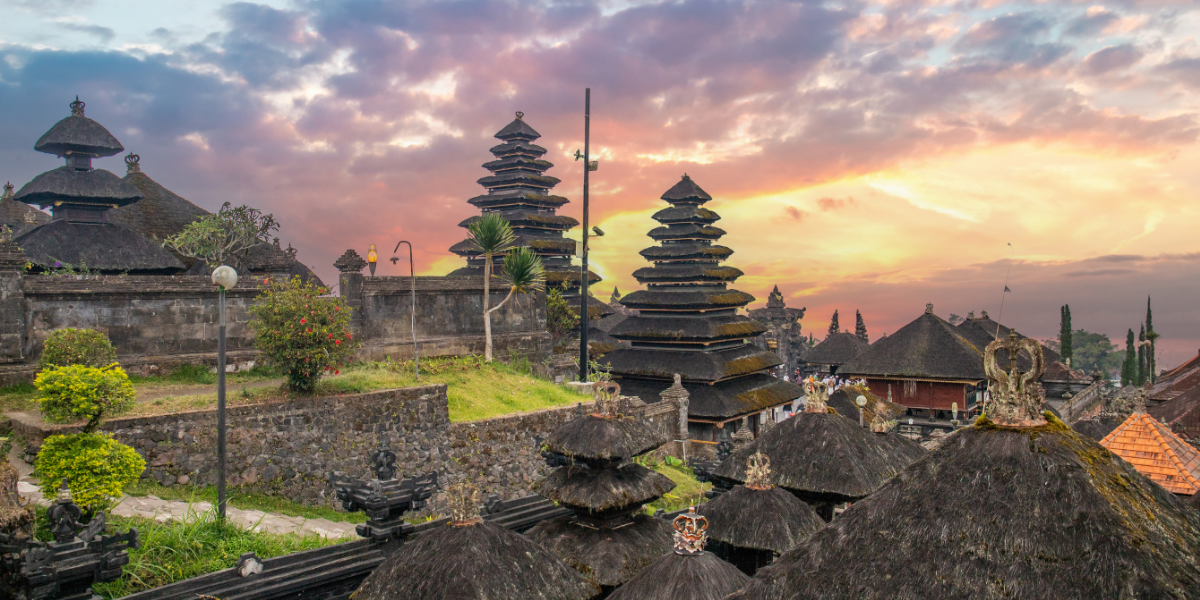
Over the years, Besakih has witnessed the ebb and flow of dynasties, the coming of new religions, and the blending of cultures, yet it has remained a constant, enduring symbol of resilience and faith.
The temple’s architecture, with its meru towers reaching towards the heavens, mirrors the Balinese philosophy of harmony between the spiritual and the material world, a concept that has guided its expansion and the addition of new sanctuaries within its complex.

The 1963 eruption of Mount Agung posed an existential threat to Besakih, yet the temple emerged virtually unscathed, a testament to its revered status and perhaps divine protection.
This miraculous survival reinforced its significance as a spiritual fortress, providing a profound narrative of faith triumphing over natural calamity.
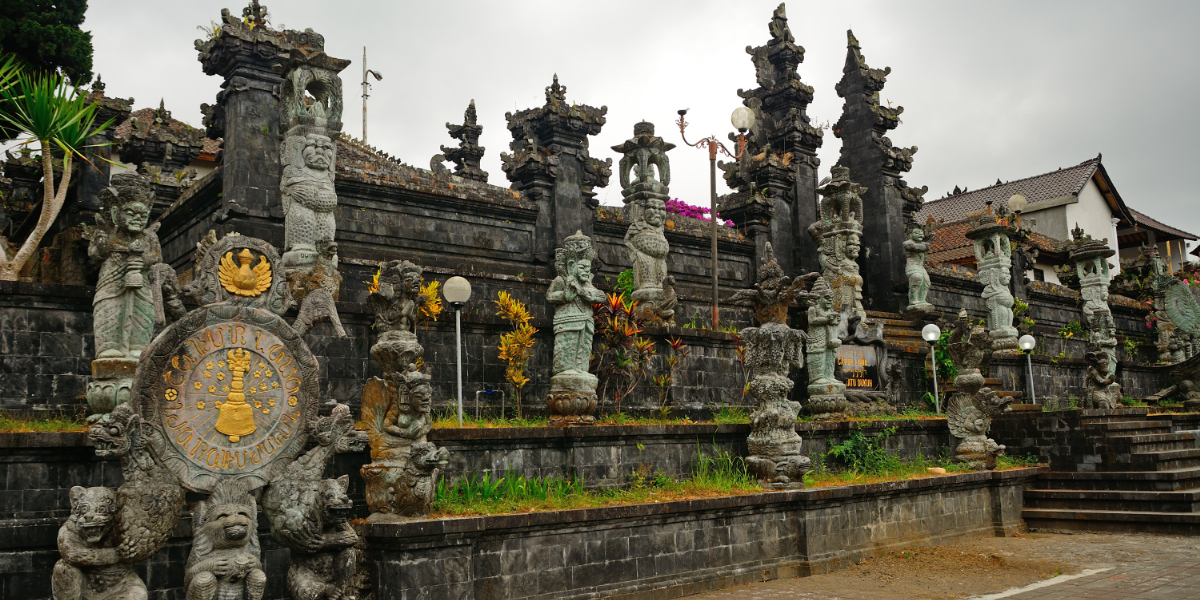
Besakih’s history is also a canvas for Balinese art and architecture.
From its intricate bas-reliefs to the grandeur of its gates and pavilions, every element tells a story of devotion, craftsmanship, and the island’s deep cultural heritage.
These artistic expressions are not merely decorative; they are teachings in stone and wood, guiding the faithful in their spiritual journey.
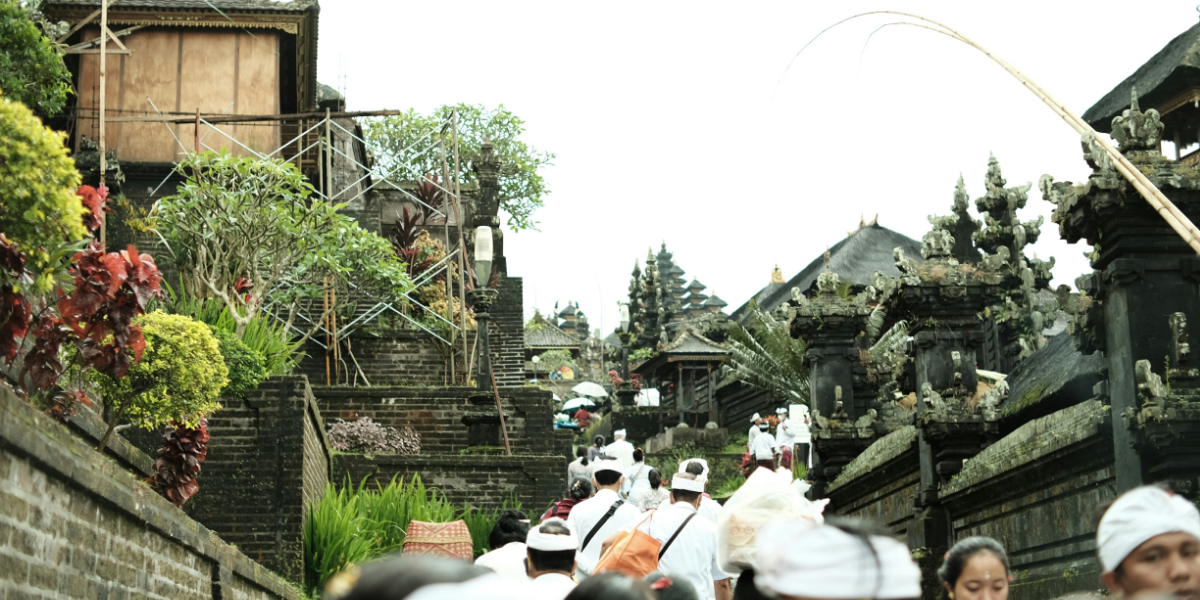
The calendar at Besakih is a cycle of ceremonies, each marking moments of cosmic significance and communal renewal.
These rituals, some tracing back to ancient rites, serve not only as expressions of faith but as living connections to the past, ensuring that the spiritual practices of ancestors continue to enrich the present.
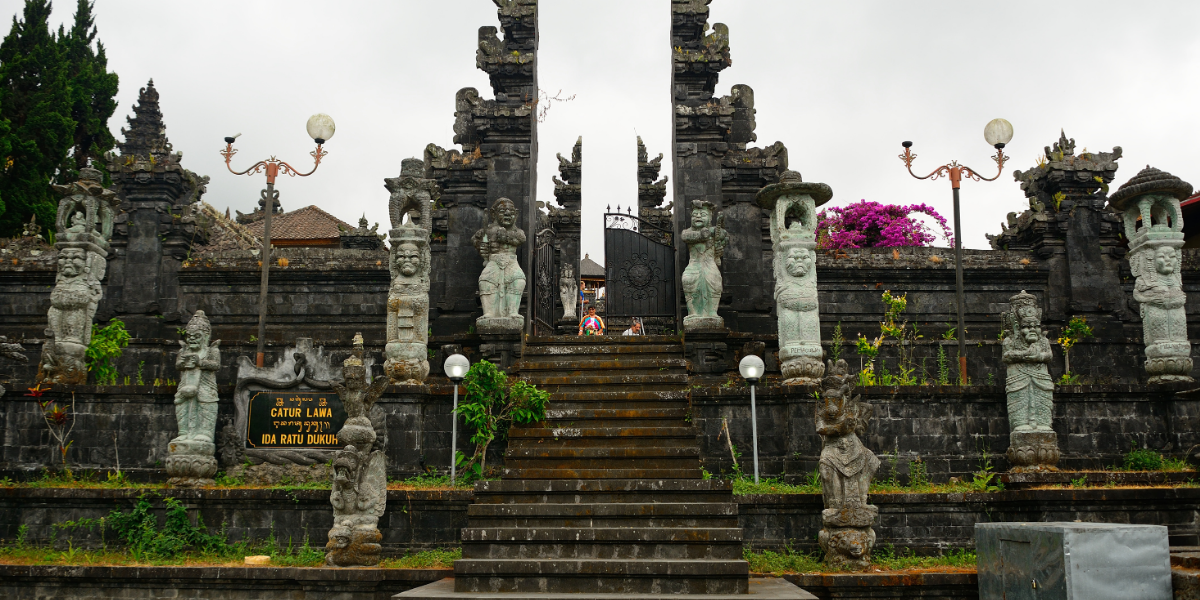
Legends abound of mythical protectors who watch over Besakih, from serpentine deities to divine guardians entrusted with the temple’s safety.
These tales, woven into the fabric of Balinese spirituality, underscore Besakih as a sacred space where the celestial and terrestrial converge, where prayers are offered, and blessings descend.

The temple’s architecture has evolved, reflecting the island’s changing dynasties and spiritual philosophies.
Yet, the core principles of its layout—symbolizing the universe and the balance between the gods, humanity, and nature—remain unchanged.
This architectural language speaks of a civilization deeply attuned to the rhythms of the cosmos and the land.
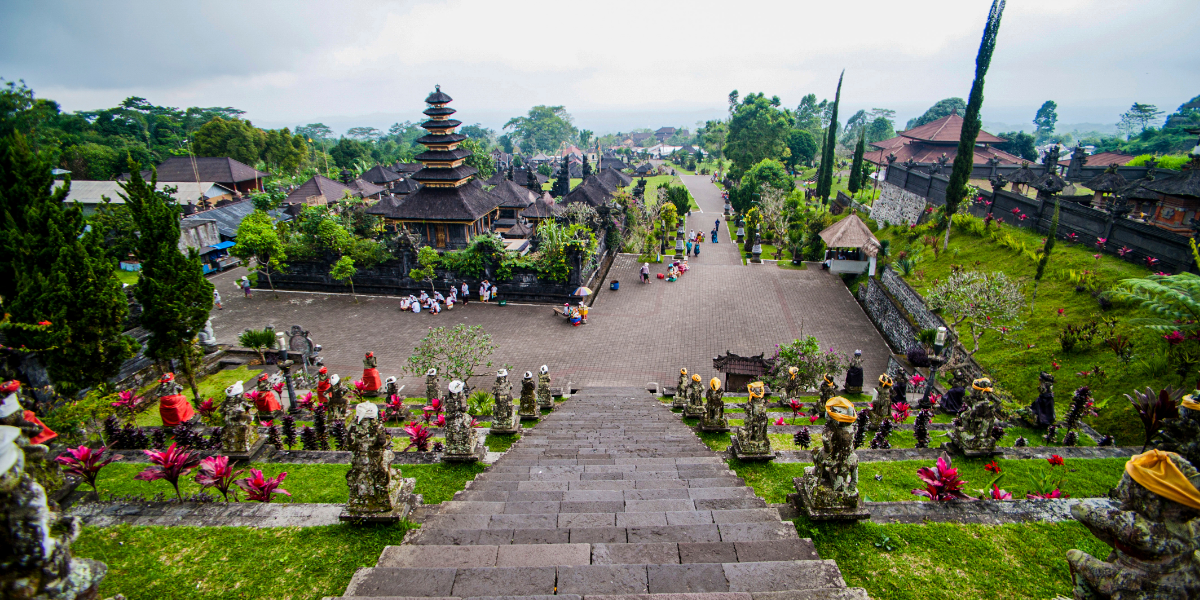
Besakih stands as the ultimate pilgrimage site in Bali, drawing devotees from across the island and the world.
This gathering of faith is a vibrant testament to the temple’s role as a spiritual home, a place where community and divine presence are intimately intertwined.
The temple’s pavilions and courtyards, alive with the sounds of ceremonies and prayers, remind visitors of the enduring power of shared belief and tradition.
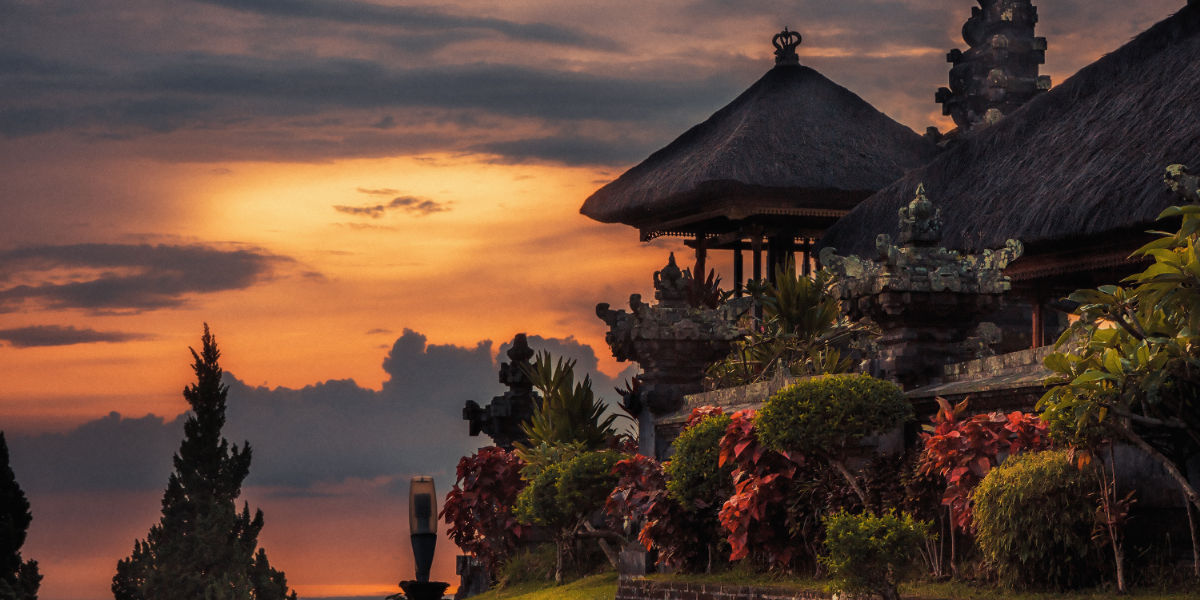
Through centuries of natural disasters, political changes, and the challenges of modernity, Besakih has remained a symbol of endurance and perseverance.
Its history is a narrative of survival and adaptation, reflecting the strength of the Balinese people and their unshakeable faith.
This resilience ensures that Besakih continues to serve as a spiritual haven, preserving the essence of Balinese Hinduism for future generations.

As a focal point of Balinese culture and spirituality, Besakih’s significance transcends its role as a mere place of worship.
It is a custodian of the island’s heritage, a center where ancient traditions are preserved, and where the spiritual, cultural, and communal identities of Bali are celebrated and renewed.
This complex, with its myriad temples and shrines, stands as a testament to the island’s rich history and its people’s devotion to their gods, their ancestors, and their community.
Contact Us
Copyright © 2025 Temples.org. All rights reserved.